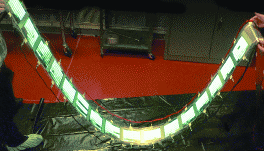GE Demonstrates World's First "Roll-to-Roll" Manufactured OLEDs
NISKAYUNA, N.Y.- GE Global Research announced on March 11 the successful demonstration of the world's first roll-to-roll manufactured organic light-emitting diode (OLED) lighting devices. According to a press release issued by the company, this demonstration is a key step toward making OLEDs and other high performance organic electronics products at dramatically lower costs than what is possible today.
"Researchers have long dreamed of making OLEDs using a newspaper-printing like roll-to-roll process," said Anil Duggal, manager of GE's Advanced Technology Program in Organic Electronics. "Now we've shown that it is possible. Commercial applications in lighting require low manufacturing costs, and this demonstration is a major milestone on our way to developing low cost OLED lighting devices.
"Beyond OLEDs, this technology also could have broader impact in the manufacturing of other organic electronic devices such as organic photovoltaics for solar energy conversion, sensors and roll-up displays."
The demonstration of a low-cost, roll-to-roll process for OLED lighting represents the successful completion of a four-year, $13 million research collaboration among GE Global Research, Energy Conversion Devices Inc. (ECD) and the U.S. Commerce Department'sNational Institute of Standards and Technology (NIST). The goal of the collaboration was to demonstrate a cost-effective system for the mass production of organic electronics products such as flexible electronic-paper displays, portable TV screens the size of posters, solar powered cells and high-efficiency lighting devices.

"This program was a major step in developing high volume roll-to-roll manufacturing for OLEDs and other organic semiconductor devices," ECD Senior Vice President Nancy Bacon said. "The success of this program is testimony to the effectiveness of NIST's advanced technology program model, and our 20-year history of pioneering research in roll-to-roll technology."
GE researchers provided the organic electronics technology and were responsible for developing the roll-to-roll processes, while ECD provided its roll-to-roll equipment-building expertise to build the machine that manufactures the OLED devices. The machine is being utilized for further manufacturing research at GE's Global Research Center in Niskayuna, New York.
According to GE, the development of this low cost roll-to-roll manufacturing process has the potential to eliminate the manufacturing hurdles that currently exist in preventing a more widespread adoption of high performance organic electronics technologies such as OLED lighting. The unique commercial equipment and technology needed to enable high performance-based organic electronics products does not currently exist. The few organic electronics products on the market today are made with more conventional batch processes and are relatively high cost. A roll-to-roll manufacturing infrastructure that enables high performance and low cost devices will allow a more widespread adoption of organic electronics products.
— Staff Reports
Samsung Electronics Acquires Clairvoyante's IP Assets
CUPERTINO, Calif. - Samsung Electronics announced on March 25 the acquisition of IP assets of Clairvoyante Inc., an IP licensing company responsible for the development of PenTile subpixel rendering display technology and associated gamut mapping algorithms. The financial terms of the agreement were not disclosed.
According to a Samsung press release, Clairvoyante's PenTile technology offers a significant reduction in power consumption for high-resolution mobile LCDs and for extending the lifetime of high-resolution mobile OLED displays, according to a Samsung press release. Samsung and Clairvoyante have worked together often in the past, most recently in October 2007, when Samsung SDIannounced that it was using PenTile subpixel rendering technology to develop the world's first high-resolution active matrix OLED panel, a handheld wVGA (480 ´ 800) OLED PenTile RGB panel.
"Samsung recognized the potential of Clairvoyante's PenTile technology to improve display performance more than seven years ago when we became the first company to license the IP," said Seung-Ho Ahn, vice president, External Affairs & IP Group at Samsung Electronics. "This new business relationship will afford us the opportunity to guide this technology in support of a wide range of markets and applications."
"The acquisition of Clairvoyante's IP assets by Samsung ensures the long term development of PenTile technology to support growing demand for high resolution devices," said Joel Pollack, CEO of Clairvoyante Inc. "The transaction also validates the ability of PenTile technology to enable best-in-class displays with greater performance and functionality for emerging designs."
After the acquisition of IP assets, Clairvoyante will be dissolved. A new entity, Nouvoyance, has been formed. It will be led byCandice Brown Elliott, a founder of Clairvoyante, and staffed with the Clairvoyante engineers. Together with Samsung, Nouvoyance will carry forward the future development of PenTile technology.
"We are pleased that Nouvoyance will be able to continue display technology development to realize the dreams of low-power, high-resolution display applications," said Elliott, who will be CEO of Nouvoyance.